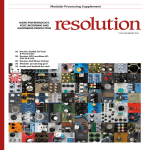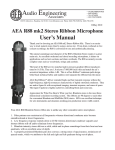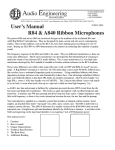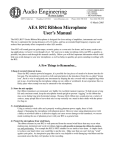Download AEA RPQ500
Transcript
Audio Engineering Associates 1029 N. Allen Ave. Pasadena CA 91104 www.ribbonmics.com Phone: (626) 798-9128 Fax: (626) 798-2378 AEA RPQ500 High Performance Preamp Owner’s Manual © December 2011 Introduction The RPQ500 module, designed after the successful RPQ preamp, provides the same ultra-clean, high-gain signal path that has earned AEA preamps their great reputation, in a 500 series package. The RPQ500 has been enhanced with additional features, turning it into a workhorse tool for your API 500 compatible rack. The RPQ500 delivers the bandwidth and quietness needed for high resolution recording. JFET circuit topology provides all the dynamics, subwoofer bass, and fast transients that your microphones can record. The input impedance of 10,000 Ω means the RPQ500 will not load down a mic and change its sound. Low Energy Storage™ circuit design instantly recovers from overloads for superior dynamic performance. The CurveShaperTM offers a natural option for sculpting your sound right at the start of the signal path. Switchable and tunable low frequency (LF) and high frequency (HF) controls allow you to tame proximity problems and provide HF extension and slope control. The high-frequency CurveShaperTM excels at adding a touch of air or presence, and the low-frequency control can remove boxiness and boominess in a fast and unobtrusive way. The bottom line is a versatile channel strip that will deliver an unadulterated performance in any application. The Line/Mic switch bypasses the microphone gain stage and allows the EQ to be used for tracking with other preamps or during mixdown. Add the output level control and the RPQ500 becomes a high-quality processing tool that can be used for mixing and mastering when combined with summing racks and mixers such as the Purple Audio Moiyn or the Roll Music Folcrom. The original RPQ with CurveShaperTM was designed to fully capture every nuance of ribbon microphones: vintage or modern, passive or phantom-powered. Engineers have discovered that the RPQ also complements their moving coil, tube and solid-state mics. By virtue of its sonic qualities and versatility, the AEA RPQ500 is the tool of choice for all microphones whenever a true and pristine signal path is needed. The Front Panel 1 – Audio Signal Level indicators: The green LED snaps on at -6 dBu to indicate the presence of signal; the red LED snaps on at +23 dBu to warn of approaching signal overload; the yellow LED varies in bright- 1 2 3 4 5 6 7 8 9 10 11 Figure 1: AEA RPQ500 Front Panel Diagram ness with the signal level from -3 dBu to +20 dBu. 2 – HF Gain control: This continuously variable control adjusts the HF gain from flat (+0dB) to maximum (+20 dB); the slope of the CurveShaperTM EQ varies interactively and directly with the boost frequency and gain settings. 3 – HF In switch: OUT is bypass; IN inserts the CurveShaperTM circuitry. 4 – HF Frequency control: This continuously variable control adjusts the +3dB break-frequency from 2.1 kHz to 26 kHz. 5 – LF In switch: OUT is bypass; IN inserts the 20 dB low-cut shelving filter. 6 – LF Filter Frequency ontrol: This continuously variable control adjusts the -3dB break-frequency of the filter from 18 Hz to 360 Hz; maximum LF reduction is -20dB. 7 – P48 switch: OUT is off; IN applies full-spec P48 Phantom Power to the input. The red LED above the switch will indicate when P48 Phantom Power is engaged. 8 – Mic/Line switch: OUT is mic input mode; IN bypasses the mic preamp stage to accomodate line-level signals. The green LED above the switch will indicate when the Line Input Mode is engaged. 9 – Polarity Invert switch: OUT is normal; IN is inverted. 10 – Input Gain rotary switch: This twelve-position switch selects from about +7 dB to +56 dB of preamplifier gain, as measured between the input and the unbalanced output. 11 – Output Gain control: This continuously variable control provides up to +19 dB additional output gain in Mic Input Mode, following the CurveShaper circuitry. It acts as a fader and allows maximum attenuation of the output signal in the full counter clockwise position. Additonal +6 dB are applied by the balanced line driver in the output stage of the module. Initial Setup The RPQ500 is a module designed for API 500 series consoles or racks. Operation of the module in racks not compatible with the API VPR alliance specification is not recommended and will void the warranty of the unit. Carefully insert the module in an open slot of your 500 series console or rack and secure it with the two flathead Phillips screws supplied with your rack. Do not place your rack on or in close proximity to any object that emits strong electro-magnetic fields, such as power transformers, motors, or RF transmitters. Similarly, do not place this unit on any surface that is hot to the touch or where it can become overheated. Before turning on the power, all connections to this unit should be made and the Gain controls (ref. #10 and #11) set at their minimum (fully counterclockwise) settings. Also before powering up this unit, be sure that the RPQ500 module is properly seated within its rack or console, and that the next item in the signal chain is turned down to prevent any sudden loud noises from damaging your system or hearing. Input Connections The RPQ500 can be operated either as a mic preamp with the optional EQ/filter, or as a standalone EQ/filter and fader for line level signals. The default mode is the Microphone Input Mode with the Line/Mic switch (ref. #8) in the OUT position. Depressing the Line/Mic switch bypasses the first gain stage and routes the signal from the XLR input connector straight to the optional CurveShaperTM circuitry and the Output Gain control (ref. #11). The Line Input Mode is indicated by the illuminated green LED above the Line/Mic switch. Microphone Input Mode With ribbon microphones, moving-coil dynamic microphones, and any other microphones that do not use phantom power it is recommended that the Phantom Power switch (ref. #7) is set to the OUT/OFF position before and while they are connected, to prevent possible damage to the microphones. The LED above the Phantom Power switch will be lit in red when P48 Phantom Power is engaged. The input impedance of the input is 10 kΩ, which means that the preamp does not load down a microphone connected to its input. This is particularly beneficial when using ribbon microphones, because they are sensitive to low preamp input impedances. A higher input impedance will generally yield higher bandwidth and higher output sensitivity. To prevent damaging the equipment in your system, it is a good idea to test your microphone cables regularly to determine whether they have any open, shorted, reversed, or intermittent connections.1 Defective Input Gain 1 Input Impedance: 10 kΩ Mic Input 1 7 10 13 17 21 26 31 36 41 45 51 56 +7 dB Output Gain Curve Shaper Line Input Input Impedance: 33 kΩ 26 kHz +20 2 Peak dB Boost 9 kHz 3 - 6 dB 2.1 kHz -64 +0 dB Level LEDs Red snaps on at +24 dBu Yellow brightens from 0 to +20 dBu Green snaps on at -6 dBu +19 +0 High Gain Balanced XLR Out (Pin 2 High) Max Gain: +81 dB +56 2 +6 dB 3 Phantom On / Off +48 V Low Cut 18 1 2 3 Filter 85 Hz 360 RPQ500 Single Line API 500 series preamp with P48 and CurveShaper Minimum path, high gain and impedance, fast transient recovery JFET preamp Audio Engineering Associates www.ribbonmics.com 626 - 798 - 9128 Handcrafted in Pasadena, California Figure 2: RPQ500 Single Line diagram cables can cause absence of signal which, as Richard Heyser once commented, is 100% distortion. Even more potentially damaging, defective cables can cause loud “pops” or other noises, which if the level is high can launch loudspeaker cones across the room. Line Input Mode The P48 Phantom Power cannot and should not be applied to line-level devices. In Line Input Mode the inputs of the RPQ500 will always be free from P48 Phantom Power, even if it is accidentally engaged. Nevertheless, it is recommended to keep the Phantom Power off when the unit is used in this mode. Output Connections The output of the RPQ500 emulates a transformer-coupled output and can be used as either a balanced or unbalanced signal (depending on how your cable/system is configured). When balanced, the maximum output level is +28 dBu; when unbalanced, the maximum level is +22 dBu. (These are as measured into a 600Ω load; the recommended load is > 10kΩ). 0 dBu = 0.7746 V rms.) When unbalancing the XLR output, pin-3 must be tied to ground at the receiving end (i.e. the input of the following device). Do not tie pin-3 to ground directly at the output of the RPQ500. As noted above, test your cables regularly to be sure that they are in proper working order. Setting the Gain Microphone Input Mode As with any piece of audio equipment, setting and maintaining proper signal levels are critical to obtaining optimum performance: if the level is too low, you sacrifice noise performance; if too high, you risk overload distortion. The AEA RPQ500 provides an easy method for setting and monitoring the system gain. The Input Gain control (ref. #10) provides from about +7 dB to +56 dB of gain for the preamplifier input stage. The Output Gain control (ref. #11) adds another +19 dB of output gain, following the CurveShaperTM circuitry, for a total of +75 dB of gain. At any gain setting, the balanced line driver adds another +6 dB to the final output for a total of +81 dB of gain available. The LED level indicators (ref. #1) monitor the signal level at a point in the signal path just prior to the input of the balanced output driver. The green LED comes on in the presence of low-level signal; the red LED turns-on when you are approaching signal overload or “clipping.” The yellow LED varies in brightness between the two to indicate the general signal level. Start with the Output Gain control (ref. #11) fully clockwise and the Input Gain control (ref. #10) fully counterclockwise. Then, with the microphone in position increase the Input Gain until the red LED turns on when the soundsource is at its loudest. If the LED is illuminated too often or too long, reduce the Input Gain control one step at a time until the red LED illuminates only briefly at the loudest peaks. Once this setting has been determined, reduce the Output Gain control to the one o’clock position. This will provide you with a little extra headroom for an optimum setting of the gain of the microphone preamplifier. Note, however, that if you subsequently apply HF boost, you may need to Figure 3: Amplitude frequency responses of mic input and filters. reduce the Input Gain control correspondingly to avoid system overload. Also remember, the energy and excitement generated during a performance guarantees that it will always be louder than the rehearsal, so after determining the gain during the sound-check it is a good idea to set the Input Gain control one or two clicks lower for the performance to allow yet a little more margin for headroom. Line Input Mode When using the Line Input mode the Input Gain control (ref. #10) is bypassed and only the Output Gain control (ref. #11) is active. For additional headroom, the signal is attenuated by 6 dB prior to the EQ/filter section and the Output Gain control. The Output Gain control can either apply up to +19 dB of gain in the full clockwise position or can attenuate the signal as much as -64 dB just like a fader on a console. The output line driver adds an additonal fixed gain of 6 dB following the Output Gain control. The unity gain position can be found near the two o’clock position. Again, the LED level indicators (ref. #1) monitor the signal level at a point in the signal path just prior to the input of the balanced output amplifier. The green LED comes on in the presence of low-level signal; the red LED turns-on when you are approaching signal overload or “clipping.” The yellow LED varies in brightness between the two to indicate the general signal level. It is suggested to start with the Output Gain control in the one o’clock position for a setting near unity gain. Note, however, that if you subsequently apply HF boost, you may need to reduce the Output Gain control correspondingly to avoid system overload. Using the LF Filter The RPQ500 was designed to complement ribbon microphones perfectly. AEA Big RibbonTM mics deliver sub-woofer lows, which the RPQ500 renders faithfully. Such strong low frequency content can mask high frequency intelligibility, so the tunable LF filter was engineered to reduce low frequency energy to appropriate levels. Directional microphones when moved closer on-axis to a sound source become more sensitive to low frequencies. This proximity effect, otherwise known as “bass tip-up,” becomes more pronounced the closer the distance. With some large transducer microphones such as the RCA-44 BX proximity effect begins at six feet and is extremely pronounced at a distance of one inch. LF filters tame proximity effect and reduce other unwanted low-frequency noise, such as air-conditioning rumble, traffic noise, “P-pops” and breath-noise noise. However, a fixed-frequency, constant slope lowcut filter cannot handle all situations effectively. The RPQ500 offers a flexible LF filter that can be tailored to satisfy the varying and critical demands of both speech and music. Pushing in the LF Filter switch (ref. #5) inserts a - 20dB (maximum) low-cut shelving filter. The tuning control (ref. #6) adjusts the -3 dB break-frequency of the filter. Setting the filter is easy: push in the LF Filter switch and adjust the tuning control until you like the sound. Then toggle the LF Filter switch quickly to compare the result against the original. In Line Input Mode, the LF Filter can be utilized to reduce low-frequency rumble and “muddiness” for more clarity and transparency. Using the HF CurveShaperTM EQ The RPQ500 features a unique CurveShaperTM circuit that enables you to add a little extra “presence” or “air” to the pickup to compensate for high-frequency losses that are inherent to most ribbon microphones, the result of distant mic placement, or an overly “dry” acoustical environment. This circuit functions similarly to a conventional parametric shelving boost, but with a significant difference: the slope varies as both the HF Frequency and HF Gain controls are adjusted. Once the HF In switch (ref. #3) is depressed to IN/ON position, adjust the continuously variable CurveShaperTM control (ref. #4) to tune the filter to the +3 dB break-frequency at and above which you want to introduce the boost. Then, dial-in the amount of boost you desire with the HF Gain control (ref. #2). The two controls are interactive, so as with the LF filter, listen carefully to determine at what frequency and gain setting you achieve satisfactory results. In Line Input Mode, the CurveShaperTM becomes a versatile EQ to add presence or air to any line level signal on a mix or even mastering. Be careful when you add HF gain because this also affects the overall gain structure of the preamplifier and could introduce overload distortion. After you make this adjustment, you may need to reduce the Input Gain control (ref. #10) correspondingly to compensate for the HF signal boost. Specifications: Electronic • 81 dB of gain at 1kHz, balanced-in to balanced-out in Microphone Input Mode • Noise figure, rms A-weighted: < 2 dB • Noise figure, rms unweighted: < 3 dB, 20 kHz LPF bandwidth • EIN < -130 dBu A-weighted, 150 Ω resistive source • Frequency response: -3dB < 1Hz and > 100 kHz • THD: < 0.02% at 1 kHz • Balanced Microphone Input Impedance: 10 kΩ • Balanced Line Input Impedance: 33 kΩ • Input Gain control: twelve-position switch provides from +7 dB to +56 dB of gain for the preamplifier circuit, as measured between the input and the before the output line driver. • Output Gain control: continuously variable from -64 dB to + 19 dB of additional output gain, following the CurveShaperTM circuitry • Switched LF Shelving filter: -3 dB break-frequency tunable from 18 Hz to 360 Hz; maximum reduction -20 dB • Switched CurveShaperTM EQ: +3dB break-frequency tunable from 2.1 kHz to 26 kHz; HF gain adjustable from +0 dB to +18 dB; the slope of the HF filter varies interactively and directly with the CurveShaperTM frequency and gain settings • XLR output maximum level into 600Ω load: +28 dBu, balanced; 0 dBu = 0.7746 V rms • XLR connectors polarity: pin-1 is ground, pin-2 is high, pin-3 is low • LED signal level indicators: green snaps on at -6 dBu, red snaps on at +23 dBu, and yellow varies in brightness with level from -3 dBu to +20 dBu. Physical • Zinc-plated steel chassis with 0.125” anodized aluminum front panel (measured without knobs and switches): 1.488” w, 6.033” d, 5.247” h (3.78 cm x 15.32 cm x 13.32 cm) • Weight: 14.5 oz (411 g) • Laser engraved front panel markings • Grayhill series 71 stepped gain switch Specifications and details subject to change without notice. WARRANTY Audio Engineering Associates its microphones and preamplifiers to be free from defects in materials and workmanship for one year. AEA offers an additional two-year extended warranty for products registered within 60 days of purchase at no charge. These warranties cover the original owner who has purchased equipment from an authorized AEA dealer and are not transferrable. These warranties do not cover user damage or abuse and are void if the product has been disassembled, repaired, or modified by anyone other than an AEA authorized service facility. Peripheral items such as cases are not covered under these warranties. No other warranties are expressed or implied. For warranty service, either an existing registration must be already on file with AEA, or an invoice from an AEA dealer showing the product serial number must accompany the equipment when it is sent to AEA. When returning equipment for service, please download and complete a repair form from www.ribbonmics.com. Please pack the equipment with at least three layers of large bubble wrap and ship to: Repair Department Audio Engineering Associates 1029 N. Allen Ave. Pasadena, CA 91104 AEA is committed to manufacturing quality products and reserves the right to make improvements to its products without notice or obligation. N.B. Disclaimer for RPQ500 modules: The RPQ500 is a module designed for API 500 series consoles or racks. Operation of the module in racks not compatible with the API VPR alliance specification is not recommended and will void the warranty of the unit. Other Products by Audio Engineering Associates: KU4 The best unidirectional ribbon ever made - made all over again. A440 The first active 44-style microphone. Finally, the warm sound you love combined with the signal strength of a powered mic. TRP High-gain 2-channel half rack unit optimized for passive ribbon microphones RPQ Two channels of ribbon preamp with CurveShaperTM in a full rack package RCA Working Reproduction Microphones and replacement parts AEA R44C Microphone - Museum Quality Reproduction Our tribute to the classic RCA 44B using new old stock ribbon material AEA 44CX Microphone 6db more output for critical digital recordings AEA 44CE Microphone The R44CE and CXE contain the same motors as their museum-quality counterparts, but use a less expensive shell for those who are interested in having that 44 sound, but would rather not pay for the museum-quality trimmings. AEA Ribbon Microphones R84 - Studio Ribbon Mic A840 - Active version of the award-winning R84 R88 mk2 - Stereo Ribbon Mic R92 - Studio Ribbon Mic specifically designed for close micing and guitar Studio Microphone Stands and Booms Modular Microphone Positioners and Decca Trees Since 1983 AEA has imported and serviced the Coles 4038 studio ribbon microphone and the 4104B, “lip” mic for voice-over work in high noise environments. We sell, service, and stock replacement parts. In North America AEA represents CB Electronics, a leading worldwide supplier of machine control equipment to the sound-for-picture industry. Their products specialize in professional control of and translation between bi-phase, 9-pin serial and time code machines. Their SR line provides low cost multiple machine remote controls for RS-422, Sony, and Tascam DA88 protocol machines. Audio Engineering Associates



























